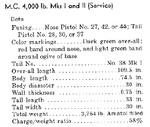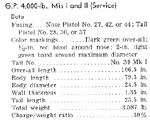Shortround6
Lieutenant General
true but they only it carried about 141 times ?,Not true.
They could also carry the 4,000lb Medium Capacity bomb.
the 4000lb High capacity bomb or light case or...... seems to have gone through several marks but some sources claim 6000-7000 were carried by mosquitoes? making the 4000lb medium capacity bomb rather a side note.
4000lb MC being the bomb on the right in the front row.
the 4000lb MK II bomb seems to have been a G.P. bomb that weighed an actual 3587lbs with 1070lbs of filler according to the bomb specification booklet recently posted.
The 1900lb GP bomb (2nd bomb-2nd row) had 470lbs of filler.
The 1st bomb-2nd row may be miss identified. There is no 2000lb MC bomb in the listings (listings may be wrong?) but the 2000lb AP bomb seems to be the right diameter and length. Since the 2000lb AP bomb only carried 166lbs of explosive there was no reason to carry it unless a major warship (Battleship) was the target.
Very true but trying for exotic loading's like a 4000lb internal and pair of 500lbs under wing or 4000lb bomb internal and under wing drop tanks puts the plane well into overload.And, yet, thy still managed to do that, night after night.
But then many, many B-17s (and other bombers ) operated well into overload conditions also. Questions are what restrictions are imposed when overloaded.



